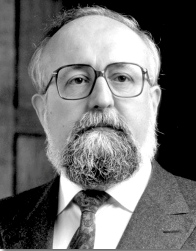
Penderecki, Thomas Works Powerful in Midwest Premiere

Polish
composer Krzysztof Penderecki is no stranger to Cincinnati, compositionally or
otherwise.

He has guest
conducted the Cincinnati Symphony Orchestra several times, most recently in Dec.
2007 for the world premiere of the updated version of his 2002 Piano Concerto. He was a favorite of former CSO music director
Jesus Lopez-Cobos, and in 1970, Erich Kunzel led the CSO premiere of his “Threnody
to the Victims of Hiroshima.”
It was the
University of Cincinnati College-Conservatory of Music’s turn Feb. 27 in
Corbett Auditorium, with the Midwest premiere of Penderecki’s 1996 Credo by the
CCM Philharmonia Orchestra, CCM Chamber
Choir, CCM Chorale, Cincinnati Children’s Choir and more than a dozen vocal soloists, all conducted by
Earl Rivers. (Directors of the Chamber
Choir, Chorale and Children’s Choir are Rivers, Brett Scott and Robyn Lana,
respectively. Mark Gibson is music director of the Philharmonia Orchestra.)

Also on the
program was the regional premiere of American composer Augusta Read Thomas’
2000 “Ring Out, Wild Bells, to the Wild Sky.”
Making it an
almost festive occasion was the presence of members of the American Choral
Directors Association, whose central division convention was held in Cincinnati
Feb. 24-26.
Not only did
they have a signal event to highlight their meeting, but the performance
confirmed once again the excellence and enterprise of the choral studies program
at CCM. Rivers, who is director of
choral studies and head of the division of ensembles and conducting at CCM, has
led many outstanding programs for the school, including the regional premiere
of Tan Dun’s Water Concerto (2008) and Bach’s Mass in B Minor performed with Bastian Cleve’s film about the work, “The Sound of Eternity" (also
in 2008).
Thomas, who
attended the concert, spent the week in residence at CCM, where she lectured, taught
master classes and coached CCM ensembles and singers. Her cantata “Ring Out Wild Bells” was
commissioned by the Choral Arts Society of Washington and premiered at the
Kennedy Center in 2001. The CCM
performance, she said, was only the second time she had heard the work (second
performances are the hardest ones to get for composers of new music).
Lasting 15
minutes and scored for solo soprano, mixed choir, a solo octet (soprano, three
mezzo-sopranos, two tenors, baritone and bass) and a full orchestra, it is a
work of considerable impact. It opened
with a tubular bell stroke momentarily evoking something akin to “Carmina Burana,”
then bubbled up through the chorus to a huge cluster chord. Corbett Auditorium was riveted immediately.
Soprano Hana
Park (recent winner of the Metropolitan Opera regional auditions) fielded a
lustrous voice against the choruses, who kept the tintinnabulation going (no
reference to Arvo Pärt intended). Thomas’ text is
drawn from Alfred Lord Tennyson’s “In Memorian A.H.H.,” a tribute to his friend
Arthur Henry Hallam, and three other Tennyson poems, “The Idealist,” “This
Nature Full of Hints and Mysteries” and “Crossing the Bar.” The overall theme is universal peace.
The vocal octet provided sung and spoken
interpolations from the side balconies in Corbett Auditorium. Mallet percussion and brasses were prominent
throughout, imparting lustrous color to the chromatic harmonies. It was an inspiring and attractive work,
surely deserving of yet a third performance (!).
Penderecki’s
Credo, a setting of the Nicene Creed, is a 50-minute work originally
meant to be part of a complete Mass setting.
The composer was so carried away by possibilities of the Credo text that
he set aside the larger work and focused on the Credo, even adding other texts
to it. These, Rivers explained in
remarks to the audience, serve as meditations and to “set the Credo text in
relief.”
You can see
why Penderecki was inspired by the Credo text, since it traverses the Trinity, incarnation, crucifixion, resurrection and every other element of the Christian
faith. It comprises seven through-composed
movements, though there was a pause here before “et resurrexit” to allow the
instrumentalists to re-tune.
It is a big
piece, requiring triple winds, a huge brass section -- 21 players here, nine of
them placed in the right balcony closest to the stage – organ, piano, celesta,
timpani, percussion (lots), harp, strings and five vocal soloists. It is emotively big, too, written in the
more traditional style of Penderecki’s later works, sometimes recalling Mahler
and Berlioz -- even Beethoven and Bach.
The colors
summoned by Penderecki and projected by the CCM ensembles were stunning, often
changing timbres rapidly, as in the opening Credo, where dark trombones and low
notes on the piano impressed themselves solemnly on the ear before piano and
harp lightened the texture and a lovely
oboe solo pointed toward the sublime end.
The somber
tone of English horn and violas led into “Crucifixus,” where sharp, individual notes
by the brasses created a lacerating effect. The tender voices of the
Children’s Choir gave a literal interpretation to the hymn “Crux fidelis” with
its reference to “sweetest wood” and “sweetest iron.” The wrenching emotions of the movement were
vividly conveyed. Soprano Kimberly
Buczek gave dramatic voice to “Pangue lingua” (“Sing, O tongue the glorious
battle”), as did the choirs in their repeated “My people, what have I done to
thee?” (sung in Latin and Polish). “Out of
the deep I cry to you,” a chorale-like homage to Bach, and the many keening
instrumental solos added further to the devastating effect.
“Et
resurrexit” conjured a moment at the tomb, with its militaristic rhythms on
drums and piano and men’s voices making the announcement of Christ’s
resurrection. It was as if delivered by
the Roman soldiers standing guard at the tomb.
The march-like buildup that followed, with brass, timpani and tubular
bell, reminded this listener of Mahler’s “Resurrection” Symphony.
“I
acknowledge one baptism” brought out gongs and speech-like passages in the
choir. A reference to the Easter hymn “Salve
festa dies” (“Hail, festive day”) was accompanied by drums, while the final
words of the Credo “the life of the world to come” and the prayer text “This is
the day which the Lord has made” were alternated and intertwined to almost giddy effect by the choirs. The children’s
voices sounded “Alleluia.” The orchestra
and choirs sounded a big “Amen,” followed by a soft halo of trumpets which brought the performance to a bright and noble end.